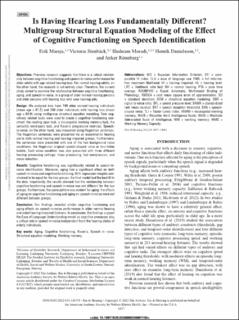| dc.contributor.author | Erik, Marsja | |
| dc.contributor.author | Victoria, Stenbäck | |
| dc.contributor.author | Moradi, Shahram | |
| dc.contributor.author | Henrik, Danielsson | |
| dc.contributor.author | Jerker, Rönnberg | |
| dc.date.accessioned | 2024-04-18T11:15:16Z | |
| dc.date.available | 2024-04-18T11:15:16Z | |
| dc.date.created | 2022-03-29T12:41:28Z | |
| dc.date.issued | 2022 | |
| dc.identifier.citation | Marsja, E., Stenbäck, V., Moradi, S., Danielsson, H., & Rönnberg, J. (2022). Is Having Hearing Loss Fundamentally Different? Multigroup Structural Equation Modeling of the Effect of Cognitive Functioning on Speech Identification. Ear and Hearing, 43(5), 1437-1446. | en_US |
| dc.identifier.issn | 0196-0202 | |
| dc.identifier.uri | https://hdl.handle.net/11250/3127218 | |
| dc.description.abstract | Objectives: Previous research suggests that there is a robust relationship between cognitive functioning and speech-in-noise performance for older adults with age-related hearing loss. For normal-hearing adults, on the other hand, the research is not entirely clear. Therefore, the current study aimed to examine the relationship between cognitive functioning, aging, and speech-in-noise, in a group of older normal-hearing persons and older persons with hearing loss who wear hearing aids.
Design: We analyzed data from 199 older normal-hearing individuals (mean age = 61.2) and 200 older individuals with hearing loss (mean age = 60.9) using multigroup structural equation modeling. Four cognitively related tasks were used to create a cognitive functioning construct: the reading span task, a visuospatial working memory task, the semantic word-pairs task, and Raven’s progressive matrices. Speech-in-noise, on the other hand, was measured using Hagerman sentences. The Hagerman sentences were presented via an experimental hearing aid to both normal hearing and hearing-impaired groups. Furthermore, the sentences were presented with one of the two background noise conditions: the Hagerman original speech-shaped noise or four-talker babble. Each noise condition was also presented with three different hearing processing settings: linear processing, fast compression, and noise reduction.
Results: Cognitive functioning was significantly related to speech-in-noise identification. Moreover, aging had a significant effect on both speech-in-noise and cognitive functioning. With regression weights constrained to be equal for the two groups, the final model had the best fit to the data. Importantly, the results showed that the relationship between cognitive functioning and speech-in-noise was not different for the two groups. Furthermore, the same pattern was evident for aging: the effects of aging on cognitive functioning and aging on speech-in-noise were not different between groups.
Conclusion: Our findings revealed similar cognitive functioning and aging effects on speech-in-noise performance in older normal-hearing and aided hearing-impaired listeners. In conclusion, the findings support the Ease of Language Understanding model as cognitive processes play a critical role in speech-in-noise independent from the hearing status of elderly individuals. | en_US |
| dc.language.iso | eng | en_US |
| dc.rights | Navngivelse 4.0 Internasjonal | * |
| dc.rights.uri | http://creativecommons.org/licenses/by/4.0/deed.no | * |
| dc.title | Is Having Hearing Loss Fundamentally Different? Multigroup Structural Equation Modeling of the Effect of Cognitive Functioning on Speech Identification | en_US |
| dc.type | Journal article | en_US |
| dc.type | Peer reviewed | en_US |
| dc.description.version | publishedVersion | en_US |
| dc.rights.holder | © 2022 The Authors. | en_US |
| dc.source.pagenumber | 1437-1446 | en_US |
| dc.source.volume | 43 | en_US |
| dc.source.journal | Ear and Hearing | en_US |
| dc.source.issue | 5 | en_US |
| dc.identifier.doi | https://doi.org/10.1097/AUD.0000000000001196 | |
| dc.identifier.cristin | 2013287 | |
| cristin.ispublished | false | |
| cristin.fulltext | original | |
| cristin.qualitycode | 2 | |

